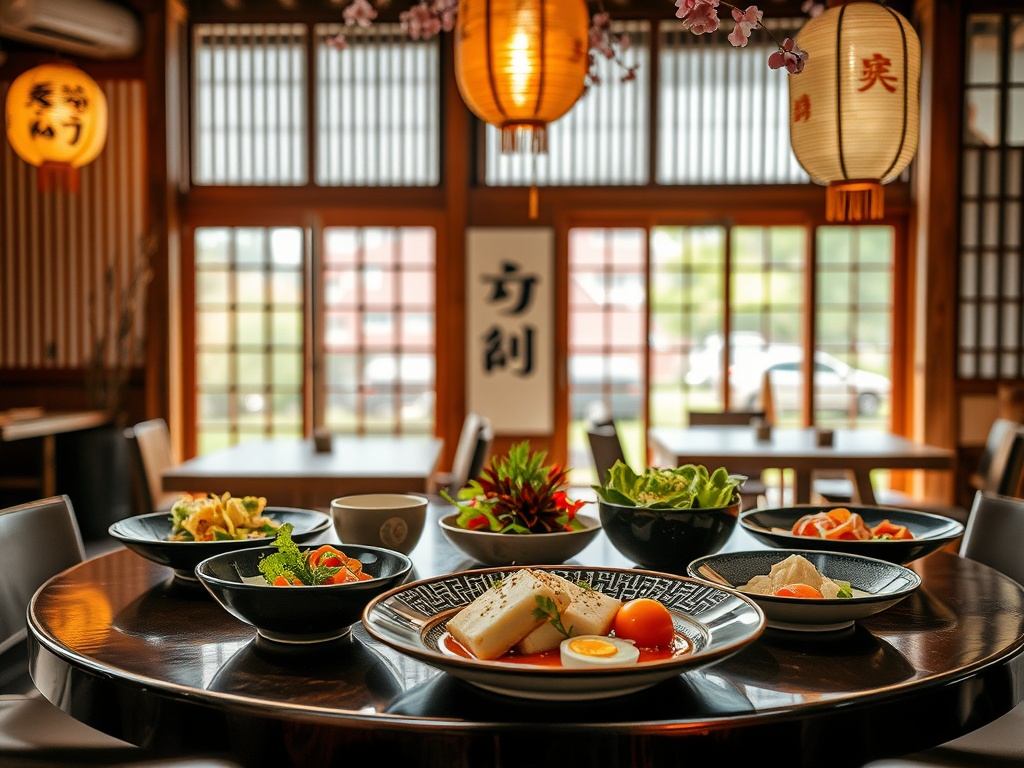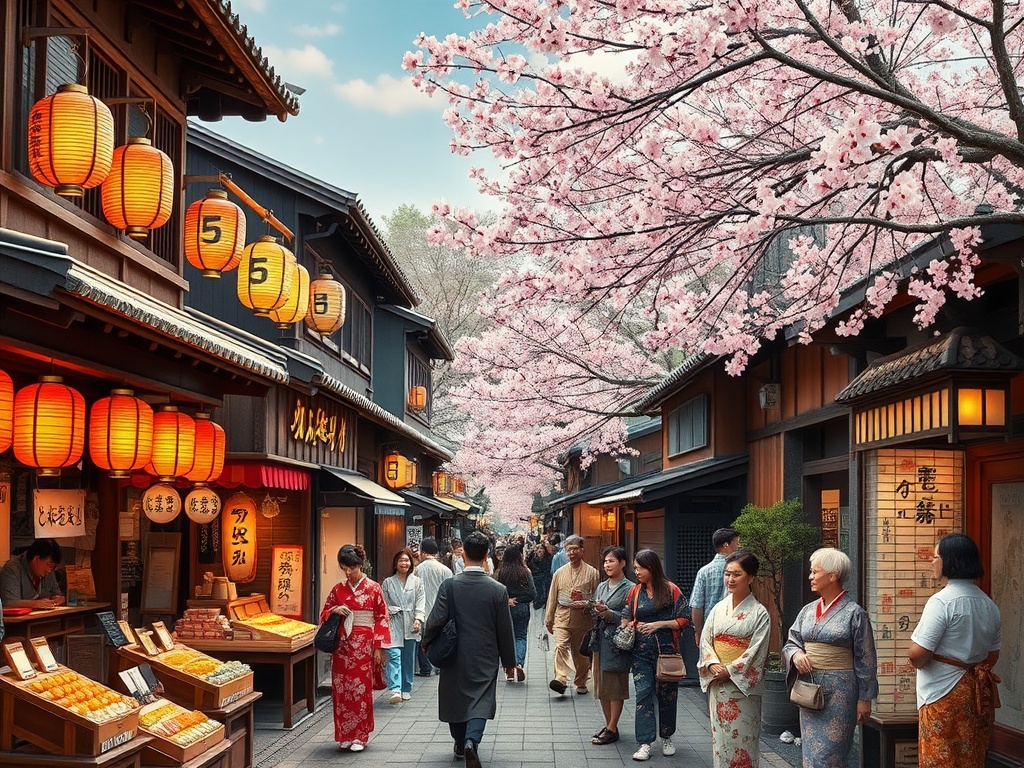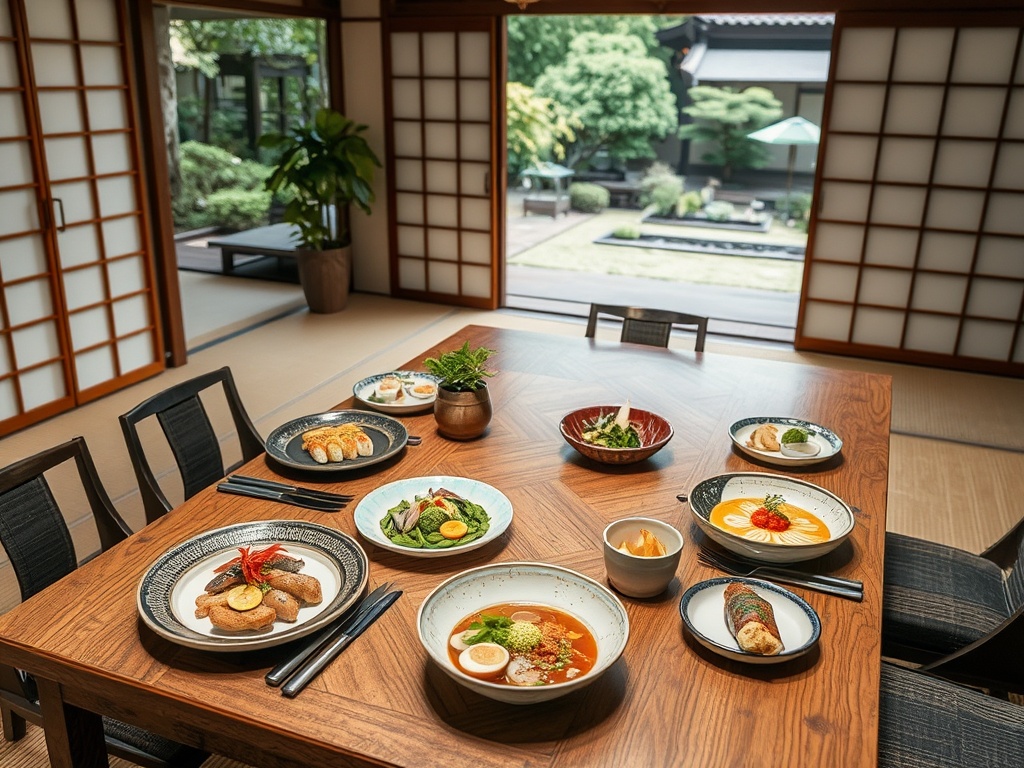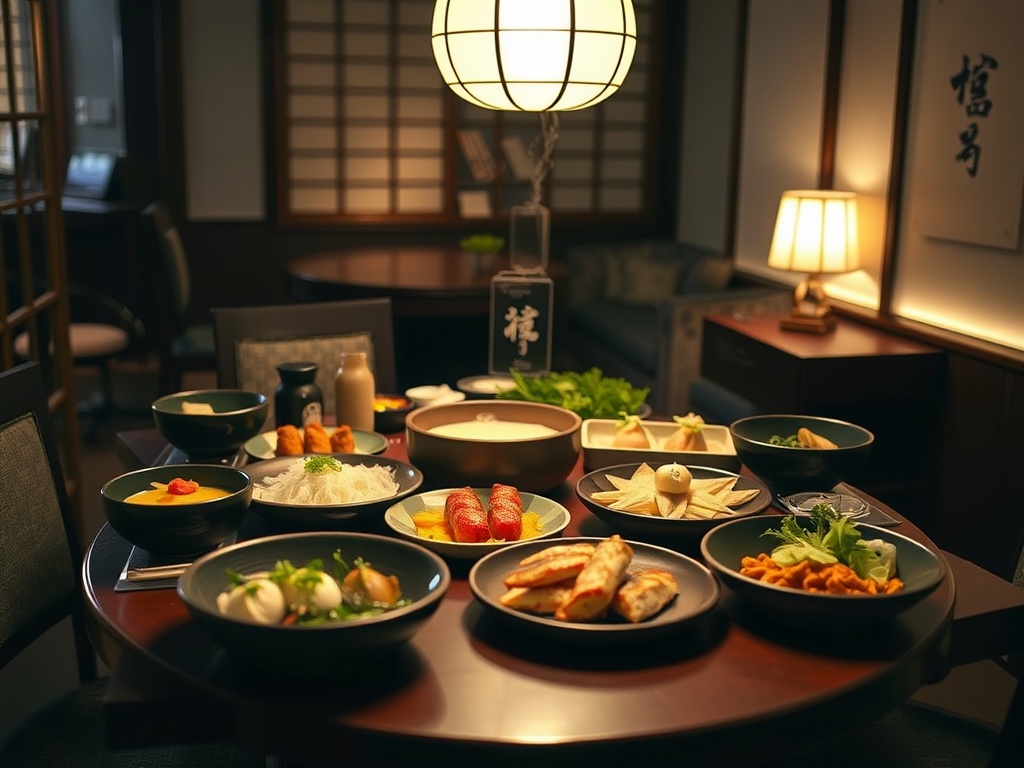A Journey Through Time: Discovering Kyoto’s Culinary Heritage
Win a Free Trip to Japan!
Experience cherry blossoms and ancient temples
Kyoto, Japan’s ancient capital, is a city where time-honored traditions and modern innovations blend seamlessly, especially when it comes to food. The culinary landscape of Kyoto is a testament to its rich history and cultural significance, offering an array of flavors that transport you back in time while tantalizing modern taste buds. As you explore this city’s gastronomic delights, you’ll find that each dish tells a story and every bite is a journey through centuries of culinary evolution.
Kaiseki is the epitome of Kyoto’s culinary tradition, an exquisite multi-course dining experience that marries art and gastronomy. Rooted in the Japanese tea ceremony, it emphasizes seasonal ingredients, meticulous presentation, and a balance of taste, texture, and appearance. As you savor each course, you’ll appreciate the harmonious interplay of flavors that reflect the essence of each season, from the delicate spring blossoms to the rich autumn harvest.
While Kyoto is renowned for its sophisticated cuisine, the city’s street food scene offers an equally delightful experience. Wander through the bustling Nishiki Market or the quaint alleyways of Gion, and you’ll discover an array of local treats that offer a more casual yet authentic taste of Kyoto.
- Yudofu: A simple yet comforting dish of boiled tofu, often served with a variety of dipping sauces.
- Yatsuhashi: A sweet confection made from rice flour, available in baked or raw forms, often flavored with cinnamon.
- Takoyaki: Savory octopus balls, crispy on the outside and soft inside, drizzled with a tangy sauce and mayonnaise.
Kyoto’s culinary scene is not just about preserving the past; it’s also about innovation. Many contemporary chefs in Kyoto are reinventing traditional dishes, using modern techniques to bring out the best in local ingredients. This fusion of old and new results in creative dishes that pay homage to Kyoto’s heritage while embracing the future of Japanese cuisine.
| Traditional Dish | Modern Variation |
|---|---|
| Sushi | Sushi with molecular gastronomy techniques |
| Matcha Tea | Matcha-infused desserts and cocktails |
Savor the Fusion: Where Ancient Recipes Meet Modern Flavors
Kyoto, with its storied past and vibrant present, is a city where culinary tradition and innovation are interwoven, creating a unique tapestry of flavors that captivate the senses. The city’s chefs are artisans who expertly blend the historical with the contemporary, crafting dishes that respect the essence of time-honored recipes while daring to push the boundaries of flavor and presentation. As you dine in Kyoto, you’ll embark on a culinary adventure that not only satisfies the palate but also tells a tale of cultural evolution.
While Kaiseki remains a cornerstone of Kyoto’s culinary identity, some chefs are reinterpreting this classic dining experience with modern twists. The traditional multi-course meal, known for its elegant presentation and seasonal ingredients, is being revitalized with elements such as molecular gastronomy and international influences. Imagine savoring a dish where the simplicity of locally-sourced vegetables is enhanced by a delicate foam or a traditional soup reimagined with a hint of exotic spices. This fusion maintains the spirit of Kaiseki while introducing diners to new horizons of taste.
In the bustling streets of Kyoto, food stalls and markets are not just preserving the past but also reinventing street food to align with contemporary palates. Take the humble Yudofu, for instance, which is now being paired with a variety of innovative dipping sauces that include flavors like truffle or wasabi-infused soy. Takoyaki, those beloved savory octopus balls, are being served with surprising fillings and toppings like cheese or kimchi, offering a delightful blend of textures and flavors that surprise and delight.
Matcha, the vibrant green tea powder that is synonymous with Japanese culture, is being embraced by modern cuisine in exciting new ways. Beyond the traditional tea ceremony, matcha is finding its place in a variety of dishes and drinks that appeal to contemporary tastes. From matcha-infused croissants to creamy matcha lattes and even cocktails, these adaptations showcase the versatility of this ancient ingredient while keeping its cultural significance alive.
Kyoto’s Hidden Gems: Traditional Dishes You Must Try
Kyoto is a treasure trove of culinary wonders, where every corner reveals a hidden gem steeped in tradition. Beyond the well-trodden paths of Kaiseki and matcha, lies a world of lesser-known dishes that promise to captivate the adventurous palate. These traditional delicacies offer a deeper insight into the city’s rich culinary heritage, each bite a testament to the artistry and devotion of Kyoto’s chefs who have preserved these flavors for generations. Embark on a gastronomic journey through Kyoto’s hidden culinary gems, where history and taste converge to create unforgettable experiences.
For those eager to explore Kyoto’s authentic flavors, a selection of traditional dishes awaits, each with its unique story and taste. These culinary delights are not just meals; they are a cultural narrative that invites you to savor the essence of Kyoto.
- Obanzai: Dive into the heart of Kyoto’s home-cooked tradition with Obanzai, a style of cuisine that emphasizes local, seasonal ingredients. This humble yet flavorful dish typically features a variety of small plates, allowing you to sample a myriad of tastes and textures that are quintessentially Kyoto.
- Saba Sushi: A beloved treat for sushi enthusiasts, Saba Sushi is a Kyoto specialty that showcases the bold flavors of mackerel. The fish is lightly pickled and paired with vinegared rice, creating a harmonious balance of taste that is both refreshing and satisfying.
- Nishin Soba: Experience the comforting warmth of Nishin Soba, a noodle dish that combines buckwheat soba and sweet, soy-marinated herring. This hearty meal is perfect for a leisurely lunch, offering a taste of Kyoto’s culinary ingenuity.
As you delve deeper into Kyoto’s culinary landscape, you’ll discover that the city’s hidden gems are a testament to its enduring gastronomic heritage. Each dish, whether enjoyed in a quaint eatery or a bustling market stall, is a piece of Kyoto’s soul, offering a glimpse into the traditions that have shaped this city. So, embark on this flavorful adventure and uncover the secrets of Kyoto’s timeless cuisine, where the past and present meld in every delectable bite.
Beyond Sushi: Exploring Kyoto’s Unique Food Culture
Kyoto, with its rich tapestry of history and culture, offers a culinary journey that extends far beyond the realms of sushi. While sushi has become synonymous with Japanese cuisine globally, Kyoto invites you to dive deeper into its unique food culture, which is an exquisite blend of tradition and innovation. Here, the culinary landscape is as much about the stories behind the dishes as it is about the flavors themselves. Whether you’re wandering through bustling markets or dining at a refined kaiseki restaurant, Kyoto’s food culture promises a symphony of tastes that reflect its storied past and vibrant present.
In Kyoto, the changing seasons are celebrated through a diverse array of dishes that highlight the freshest local ingredients. The city’s chefs are true artisans, crafting menus that are not only delicious but also visually stunning, with each dish reflecting the beauty of the current season. From the delicate flavors of bamboo shoots in spring to the robust taste of chestnuts in autumn, every ingredient is carefully chosen to create a harmonious balance of taste and texture. This seasonal approach to cooking is a cornerstone of Kyoto’s culinary philosophy, offering a unique perspective on how nature’s bounty can be transformed into art on a plate.
Beyond sushi, tofu plays a central role in Kyoto’s food culture, celebrated for its versatility and subtle flavors. Kyoto is renowned for its high-quality tofu, which is crafted using pristine water from the region’s abundant springs. This simple yet elegant ingredient is used in a variety of dishes, from the comforting warmth of yudofu to the delicate textures of tofu skin sashimi. Chefs in Kyoto have mastered the art of elevating tofu to new heights, showcasing its potential in both traditional and contemporary cuisine.
To experience the true essence of Kyoto’s tofu, visit a local tofu specialty shop or restaurant where you can savor dishes like tofu steak, which pairs the creamy texture of tofu with bold, flavorful sauces. Whether enjoyed as a main course or a side dish, tofu in Kyoto is a testament to the city’s dedication to culinary excellence and innovation.
Tea Ceremonies and Tempura: A Taste of Kyoto’s Past
Kyoto, a city that embodies the essence of Japan’s historical and cultural tapestry, offers a multitude of culinary experiences that transport you back in time. Among these, the traditional tea ceremonies and the art of tempura stand out as quintessential expressions of Kyoto’s rich heritage. Both traditions, deeply rooted in the city’s past, offer a glimpse into the meticulous artistry and reverence for nature that define Kyoto’s culinary landscape, providing travelers with a unique opportunity to savor the flavors of bygone eras while appreciating their modern interpretations.
The tea ceremony, or chanoyu, is more than just a ritual of drinking tea; it is a profound cultural experience that embodies the principles of harmony, respect, purity, and tranquility. In Kyoto, renowned for its tea culture, these ceremonies are a delicate dance of tradition and artistry. As you participate, you’ll be enveloped in the serene ambiance of a Japanese tea house, witnessing the careful preparation and presentation of matcha. The ceremony invites you to slow down and appreciate the subtle flavors and aromas of the tea, each sip offering a moment of reflection and connection to Kyoto’s storied past.
Today’s tea ceremonies in Kyoto often incorporate modern twists while respecting traditional elements. Many tea houses now offer fusion experiences, where traditional matcha is paired with innovative sweets that incorporate international flavors, providing an exciting interplay between the old and the new. This evolution not only honors Kyoto’s heritage but also makes the tea ceremony accessible and enjoyable for contemporary audiences.
Tempura, a beloved dish that originated from the influence of Portuguese traders, has become a staple of Japanese cuisine, and Kyoto offers a unique take on this crispy delight. In the heart of the city, you’ll find tempura prepared with the utmost precision, using the freshest seasonal ingredients coated in a light, airy batter. Each piece is a testament to the chef’s skill, offering a perfect balance of texture and flavor that is both satisfying and elegant.
While traditional tempura remains a favorite, Kyoto’s chefs are not afraid to experiment, infusing this classic dish with modern culinary techniques and ingredients. Imagine savoring tempura made with local Kyoto vegetables or even exotic ingredients from around the world, each bite offering a surprising twist on the familiar. This harmonious blend of tradition and innovation makes tempura a must-try for any culinary enthusiast exploring Kyoto’s vibrant food scene.
From Markets to Michelin Stars: The Evolution of Kyoto Cuisine
Kyoto’s culinary journey is a fascinating narrative of transformation, where the heart of traditional flavors pulses in rhythm with contemporary innovation. This journey, marked by a seamless transition from bustling street markets to Michelin-starred restaurants, reflects a city that holds its heritage close while embracing the new waves of gastronomic exploration. Traveling through Kyoto is not just a physical journey but a sensory expedition through time, where each meal is a page in the city’s rich culinary book.
In Kyoto, the markets are more than just places to purchase fresh produce; they are vibrant arenas where the essence of the city’s culinary traditions comes alive. As you meander through places like Nishiki Market, you’ll be enveloped by the scents of grilled seafood, the vibrant colors of seasonal vegetables, and the chatter of vendors preserving age-old recipes. Here, tradition is palpable, and every stall tells a story of Kyoto’s culinary past. The market is a playground for the senses, offering a tapestry of flavors that range from the simplicity of yudofu to the sweetness of yatsuhashi.
As Kyoto’s culinary narrative progresses from its bustling markets, it reaches new heights in the refined elegance of its Michelin-starred restaurants. In these culinary sanctuaries, chefs are architects of innovation, crafting masterpieces that deftly blend traditional ingredients with modern techniques. These dining experiences are a testament to Kyoto’s ability to honor its roots while setting trends, with dishes that are as visually stunning as they are delicious. The Michelin stars are not just accolades; they represent a commitment to pushing the boundaries of flavor, ensuring that Kyoto remains at the forefront of global cuisine.
The evolution from markets to Michelin stars is a journey of passion and dedication, showcasing Kyoto’s unique ability to bridge the gap between the past and the present. As you explore the city’s culinary landscape, you’ll discover that each meal is a harmonious blend of history and modernity, inviting you to savor the time-honored traditions that have shaped Kyoto’s gastronomic identity.
The Art of Kyo-kaiseki: Elegance on a Plate
In Kyoto, the culinary artistry of Kyo-kaiseki is a timeless tradition that perfectly encapsulates the city’s harmonious blend of history and innovation. This exquisite multi-course meal is a feast for the senses, where each plate is a canvas, meticulously crafted to reflect the beauty of the seasons and the rich cultural tapestry of Kyoto. As you embark on this culinary journey, you’ll find that Kyo-kaiseki is not just a meal, but an experience that celebrates the symbiosis of taste, art, and nature.
At the heart of Kyo-kaiseki lies the shun philosophy—an unwavering dedication to using seasonal ingredients at their peak. This deep respect for nature’s bounty results in dishes that are as fleeting as they are memorable, with flavors that capture the essence of each season. Whether it’s the delicate sweetness of spring’s cherry blossoms or the earthy tones of autumn mushrooms, every ingredient is chosen with the utmost care to create a symphony of flavors that dance across the palate.
Kyo-kaiseki is renowned for its breathtaking presentation, where each course is a masterpiece that mirrors the elegance of Kyoto’s traditional artistry. The use of vibrant colors, intricate garnishes, and delicate arrangements transforms each dish into a visual delight. This attention to detail is not just for aesthetics; it is a reflection of the Japanese belief in the unity of beauty and taste, where the visual allure enhances the dining experience. Diners are often left in awe, as the presentation itself becomes a part of the meal’s narrative.
Noteworthy Kyo-kaiseki Elements:
- Hassun: A seasonal platter that sets the tone, showcasing the chef’s skill in balancing flavors and textures.
- Mukozuke: A beautifully arranged sashimi selection, highlighting the freshness and quality of the seafood.
- Takiawase: A simmered dish where vegetables and proteins are artfully paired to accentuate their natural tastes.
While Kyo-kaiseki honors tradition, it is also a canvas for culinary innovation. Contemporary chefs in Kyoto are embracing the challenge of infusing modern techniques and global influences into this ancient dining form. By subtly incorporating elements like sous-vide cooking or international spices, they add new dimensions to classic dishes, creating a dining experience that is both familiar and refreshingly novel. This evolution ensures that Kyo-kaiseki remains a dynamic and enduring art form, captivating food enthusiasts from around the world.
Sweet Tradition: Kyoto’s Timeless Confections
Kyoto’s dessert scene is a delightful journey into the past, where ancient recipes are lovingly preserved in vibrant forms, offering a taste of history with every bite. These confections are not just sweets; they are a testament to the city’s rich cultural heritage, infused with the same elegance and precision that define Kyoto’s culinary landscape. As you wander through the city, you’ll find that Kyoto’s sweet offerings seamlessly blend tradition and modernity, creating a unique experience that captivates both the taste buds and the imagination.
Wagashi, the traditional Japanese confection, is a true expression of Kyoto’s dedication to artistry and flavor. These exquisite sweets are crafted to reflect the seasons, with each piece showcasing nature’s beauty in edible form. Made predominantly from ingredients like red bean paste, rice flour, and agar, wagashi is not only a treat for the palate but also a visual feast. In Kyoto, the creation of wagashi is considered an art form, with artisans honing their craft over decades to achieve the perfect balance of taste, texture, and appearance. Whether enjoyed during a traditional tea ceremony or as a standalone delicacy, wagashi offers a glimpse into Kyoto’s past while embracing the present.
Among Kyoto’s most beloved sweets is yatsuhashi, a confection that has become synonymous with the city’s culinary identity. This treat, available in both baked and raw forms, is renowned for its delicate aroma of cinnamon and its delightful chewy texture. The raw version, known as nama yatsuhashi, is particularly popular, often filled with sweet red bean paste or other innovative flavors that appeal to modern tastes. As you savor yatsuhashi, you are partaking in a tradition that has been cherished for centuries, yet continues to evolve with contemporary influences, making it a perfect symbol of Kyoto’s culinary innovation.
In Kyoto, the art of confectionery is more than a culinary pursuit; it is a cultural journey that bridges the past and present. Each sweet treat tells a story, inviting you to explore the city’s unique blend of tradition and modernity. As you indulge in these timeless confections, you’ll discover that Kyoto’s desserts are not merely about satisfying a sweet tooth but are an integral part of the city’s enduring charm and gastronomic legacy.



